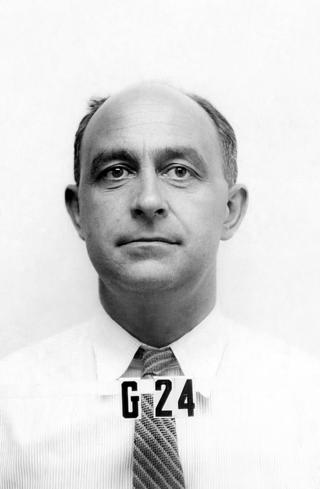Applications for self-replicating spacecraft
The details of the mission of self-replicating starships can vary widely from proposal to proposal, and the only common trait is the self-replicating nature.
Von Neumann probes
A von Neumann probe is a spacecraft capable of replicating itself. [2] It is a concatenation of two concepts: a Von Neumann universal constructor (self-replicating machine) and a probe (an instrument to explore or examine something).[ citation needed ] The concept is named after Hungarian American mathematician and physicist John von Neumann, who rigorously studied the concept of self-replicating machines that he called "Universal Assemblers" and which are often referred to as "von Neumann machines". [2] Such constructs could be theorised to comprise five basic components (variations of this template could create other machines such as Bracewell probes [ jargon ]):
- Probe: which would contain the actual probing instruments & goal-directed AI to guide the construct.
- Life-support systems: mechanisms to repair and maintain the construct.
- Factory: mechanisms to harvest resources & replicate itself.
- Memory banks: store programs for all its components & information gained by the probe.
- Engine: motor to move the probe.[ citation needed ]
Andreas M. Hein and science fiction author Stephen Baxter proposed different types of von Neumann probes, termed "Philosopher" and "Founder", where the purpose of the former is exploration and for the latter preparing future settlement. [7] [ better source needed ]
A near-term concept of a self-replicating probe has been proposed by the Initiative for Interstellar Studies,[ clarification needed ] achieving about 70% self-replication, based on current and near-term technologies. [8]
If a self-replicating probe finds evidence of primitive life (or a primitive, low-level culture) it might be programmed to lie dormant, silently observe, attempt to make contact (this variant is known as a Bracewell probe),[ jargon ] or even interfere with or guide the evolution of life in some way.[ citation needed ]
Physicist Paul Davies of University of Adelaide has "raised the possibility of a probe resting on our own Moon", having arrived at some point in Earth's ancient prehistory and remained to monitor Earth, a concept that, per Michio Kaku, was what Stanley Kubrick used as the basis of his film, 2001: A Space Odyssey (though the director cut the relevant monolith scene from the movie). [9] Kubrick's work was based on Arthur C. Clarke's story, "The Sentinel", expanded by the pair in the form of a novel that became the basis for the movie [10] and so Davies' lunar probe/observatory concept is also considered reminiscent of Clarke.[ citation needed ]
A variant idea on the interstellar von Neumann probe idea is that of the "Astrochicken", proposed by Freeman Dyson.[ citation needed ] While it has the common traits of self-replication, exploration, and communication with its "home base", Dyson conceived the Astrochicken to explore and operate within our own planetary system, and not explore interstellar space.[ citation needed ]
Anders Sandberg and Stuart Armstrong argued that launching the colonization of the entire reachable universe through self-replicating probes is well within the capabilities of a star-spanning civilization, and proposed a theoretical approach for achieving it in 32 years, by mining planet Mercury for resources and constructing a Dyson Swarm around the Sun. [11]
Berserkers
A variant of the self-replicating starship is the Berserker. Unlike the benign probe concept, Berserkers are programmed to seek out and exterminate lifeforms and life-bearing exoplanets whenever they are encountered.
The name is derived from the Berserker series of novels by Fred Saberhagen which describes a war between humanity and such machines. Saberhagen points out (through one of his characters) that the Berserker warships in his novels are not von Neumann machines themselves, but the larger complex of Berserker machines – including automated shipyards – do constitute a von Neumann machine. This again brings up the concept of an ecology of von Neumann machines, or even a von Neumann hive entity.
It is speculated in fiction that Berserkers could be created and launched by a xenophobic civilization (see Anvil of Stars , by Greg Bear, in the section In fiction below) or could theoretically "mutate" from a more benign probe. For instance, a von Neumann ship designed for terraforming processes – mining a planet's surface and adjusting its atmosphere to more human-friendly conditions – could be interpreted as attacking previously inhabited planets, killing their inhabitants in the process of changing the planetary environment, and then self-replicating to dispatch more ships to "attack" other planets.
Replicating seeder ships
Yet another variant on the idea of the self-replicating starship is that of the seeder ship. Such starships might store the genetic patterns of lifeforms from their home world, perhaps even of the species which created it. Upon finding a habitable exoplanet, or even one that might be terraformed, it would try to replicate such lifeforms – either from stored embryos or from stored information using molecular nanotechnology to build zygotes with varying genetic information from local raw materials. [12]
Such ships might be terraforming vessels, preparing colony worlds for later colonization by other vessels, or – should they be programmed to recreate, raise, and educate individuals of the species that created it – self-replicating colonizers themselves. Seeder ships would be a suitable alternative to generation ships as a way to colonize worlds too distant to travel to in one lifetime.











